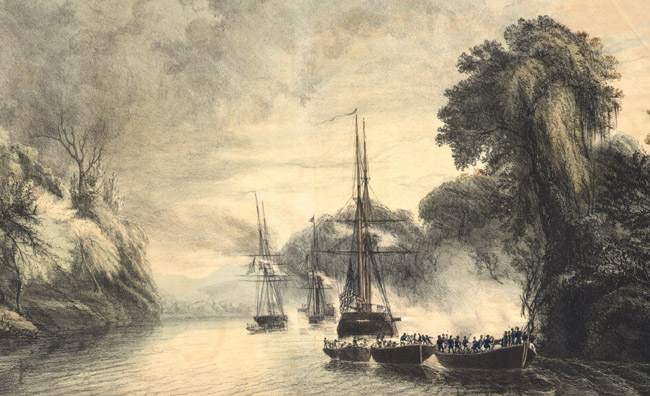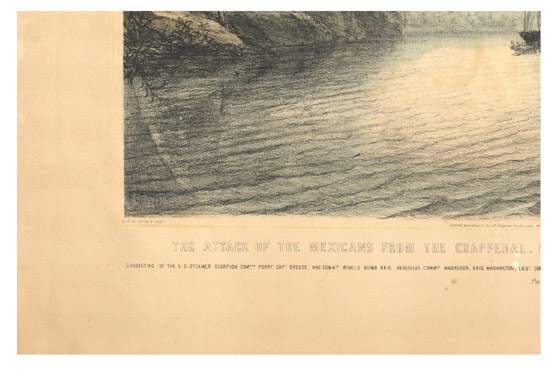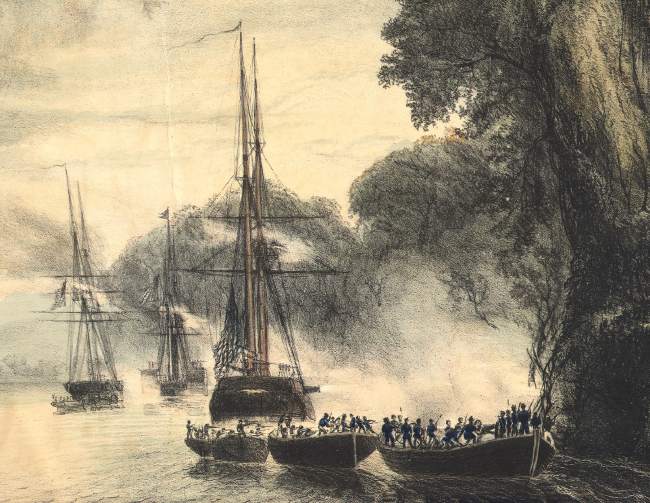|
~~ 1848090524-4 ~~
Naval Portfolio, No 4.
 Overall Condition of Paper. The paper is toned. The back is much more toned than the front. The paper is supple and not brittle. Lithograph Paper Compared Against a Bright White Background  Foxing & Staining. There is a 2 cm circular stain at the top just below the portfolio number lettering. There are areas of waterstaining visible in the margin on the back of the plate. Except for a small area at the bottom middle edge, waterstaining is not visible on the front of the plate. Tears & Creases. The lithograph has several significant creases. The worst crease is a vertical crease which passes through 80% of the image area at the mid-point of the plate. The crease can be seen when viewing the lithograph head on. To see a close up of this, click here. If you examine the plate surface by looking across it from the side, there are colorless spots along 4 cm of the tear line where it appears something has been applied to mend the tear caused by the crease. This treatment is not visible when you look at the plate head on. There are noticeable diagonal creases across all corners except the bottom left corner. Some of these crease can be seen when the plate is viewed head on, particularly one in the bottom right corner. However, I don't believe that any of these diagonal crease have broken the paper. There are approximately 5-6 small edge tears that have been repaired. None of them is over 1 cm in length and none of them intrude into the image area. Back of the Lithograph. To see a view of the entire back of the lithograph, click here. Size of the Lithograph Plate. I believe the plate is untrimmed. It has full and relatively even margins. The plate measures 20 3/4 x 26 3/4+ in (53 x 68 cm). Perhaps the rarest American Naval print series was created by then Lieutenant H. (Henry) Walke. It is a series of eight lithographs depicting Naval actions in the Mexican War in the Spring and Summer of 1847. Walke served in the war as the second in command of the U.S.S. Vesuvius, a bomb brig of the Gulf Squadron. During the war the Vesuvius participated in the blockade of Laguna and supported landings at Tuxpan and Tabasco. After serving for eight months on the Vesuvius, Walke returned to the United States in October 1847 and went on extended leave until September of 1848. On his return he immediately began work on his Naval lithograph portfolio and it was completed during this period. All of the lithographs were after original art by Walke. He personally rendered five of them onto the lithograph stones. Numbers 1, 3, 4, 5 & 7 were executed by Walke onto the lithograph stones. The others (Nos. 2, 6 & 8) were executed on the lithograph stones by others but based upon Walke's original art. "Naval Portfolio .... No. 1~8" is stated at the top of each lithograph. There is also a line of text in smaller print reading "Naval Scenes in the Mexican War by H. Walke, Lieut. U.S. Navy." The image is surrounded by a thick (2~4 mm wide) frame box. Directly below the image and within the frame box, small print text is seen at the left (lithographer - "Sarony & Major"), middle ("Entered according to Act of Congress in the year 1847 (1848)...."). Those lithographs actually executed by Walke on the lithograph stone (Nos 1, 3, 4, 5 & 7) state "Executed by H. Walke, Lt, U.S.N." or "Designed and Drawn on Stone by H. Walke, Lt, U.S.N." at the far right. When the H. Walke work was actually rendered onto the lithograph stone by another artist (Nos. 2, 6 & 8) at the far left it states "Painted by H.Walke L. U.S.N, Drawn on Stone by (name of artist)." At the bottom under the image frame box in large print is the title of the image in double line letters. This is followed by lines of smaller print with descriptive text which contains a date of for the naval action depicted. On some of the lithographs the name and address of the lithographer/publisher ("Published by Sarony & Major, 117 Fulton Street, New York.") is stated below the descriptive text. The name of the publisher/lithographer (Sarony & Major) is often found at the far right or far left under the image but within the image box. The plate size of these lithographs is generally 20 3/4 x 26 3/4+ in (53 x 68 cm). The Yale University Library lists the size of the prints as 54 x 73 cm. The image areas (including the image frame box) vary slightly but generally measure 15~15 1/4 x 21 1/4~22 1/2 in (37.8~38.5 x 53.8~56.8 cm). The most of the lithographs I would call tinted lithographs. There are executed in black & white and contain an additional tint color tint. Some of the lithographs contain more that one tint and appear to be properly classified as multi-color (chromolithographs). This work is sometimes described as a book. It apparently was issued with a folio case to house the loose lithographs. Complete sets of all eight lithographs are rarely seen. Even single lithographs are seldom seen and generally in poor condition. The Library of Congress on-line exhibit titled "Pictorial America" contains all 8 of these lithographs.
Naval Portfolio No. 4Consisting of the U.S. Steamer Scorpion Comore. Perry. Capt. Breese and Comaer. Bigelo Bomb Brig Vesuvius. Comaer.Magruder. Brig Washington, Lieut. Comaer. S.S. Lee. With a Detachment of Seamen and Marines in Barges from the Steam Frigate Mississippi; Under, Comaer. Mackenzie and H.A. Adams, Marines Comanded by Capt. Edson." "Designed and Drawn on Stone by H. Walke, Lt. U.S.N." The image presented in this lithograph was discussed by William Elliot Griffis in his biography of M. C. Perry.
THE NAVAL BRIGADE. CAPTURE OF TABASCO. A tinted lithograph. The plate measures 20 3/4 x 26 3/4+ in (53 x 68 cm). The image (including the image frame box) measures 15 x 21 1/4 in (37.8 x 53.8 cm).
|





